Page 310 of 426
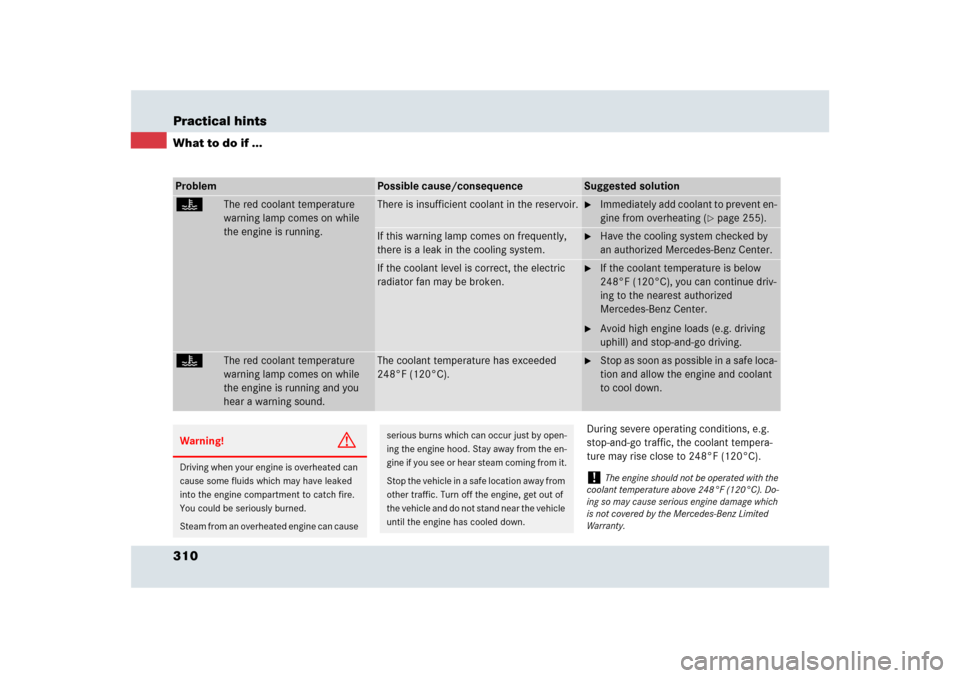
310 Practical hintsWhat to do if ...
During severe operating conditions, e.g.
stop-and-go traffic, the coolant tempera-
ture may rise close to 248°F (120°C).
Problem
Possible cause/consequence
Suggested solution
D
The red coolant temperature
warning lamp comes on while
the engine is running.
There is insufficient coolant in the reservoir.
�
Immediately add coolant to prevent en-
gine from overheating (
�page 255).
If this warning lamp comes on frequently,
there is a leak in the cooling system.
�
Have the cooling system checked by
an authorized Mercedes-Benz Center.
If the coolant level is correct, the electric
radiator fan may be broken.
�
If the coolant temperature is below
248°F (120°C), you can continue driv-
ing to the nearest authorized
Mercedes-Benz Center.
�
Avoid high engine loads (e.g. driving
uphill) and stop-and-go driving.
D
The red coolant temperature
warning lamp comes on while
the engine is running and you
hear a warning sound.
The coolant temperature has exceeded
248°F (120°C).
�
Stop as soon as possible in a safe loca-
tion and allow the engine and coolant
to cool down.
Warning!
G
Driving when your engine is overheated can
cause some fluids which may have leaked
into the engine compartment to catch fire.
You could be seriously burned.
Steam from an overheated engine can cause
serious burns which can occur just by open-
ing the engine hood. Stay away from the en-
gine if you see or hear steam coming from it.
Stop the vehicle in a safe location away from
other traffic. Turn off the engine, get out of
the vehicle and do not stand near the vehicle
until the engine has cooled down.
!
The engine should not be operated with the
coolant temperature above 248°F (120°C). Do-
ing so may cause serious engine damage which
is not covered by the Mercedes-Benz Limited
Warranty.
Page 311 of 426
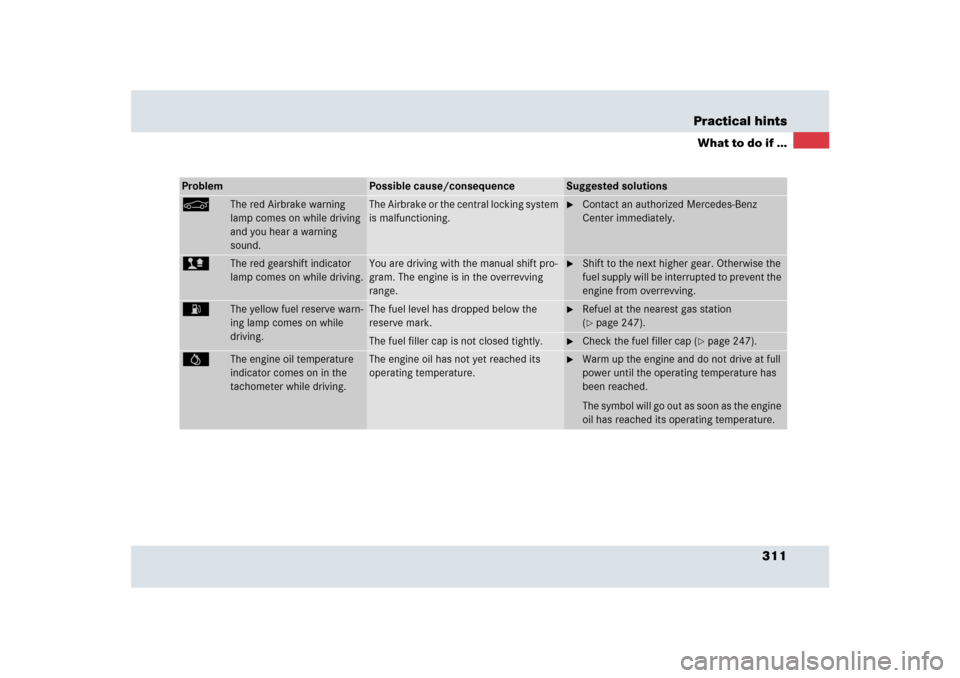
311 Practical hints
What to do if ...
Problem
Possible cause/consequence
Suggested solutions
<
The red Airbrake warning
lamp comes on while driving
and you hear a warning
sound.
The Airbrake or the central locking system
is malfunctioning.
�
Contact an authorized Mercedes-Benz
Center immediately.
>
The red gearshift indicator
lamp comes on while driving.
You are driving with the manual shift pro-
gram. The engine is in the overrevving
range.
�
Shift to the next higher gear. Otherwise the
fuel supply will be interrupted to prevent the
engine from overrevving.
A
The yellow fuel reserve warn-
ing lamp comes on while
driving.
The fuel level has dropped below the
reserve mark.
�
Refuel at the nearest gas station
(�page 247).
The fuel filler cap is not closed tightly.
�
Check the fuel filler cap (
�page 247).
=
The engine oil temperature
indicator comes on in the
tachometer while driving.
The engine oil has not yet reached its
operating temperature.
�
Warm up the engine and do not drive at full
power until the operating temperature has
been reached.
The symbol will go out as soon as the engine
oil has reached its operating temperature.
Page 312 of 426
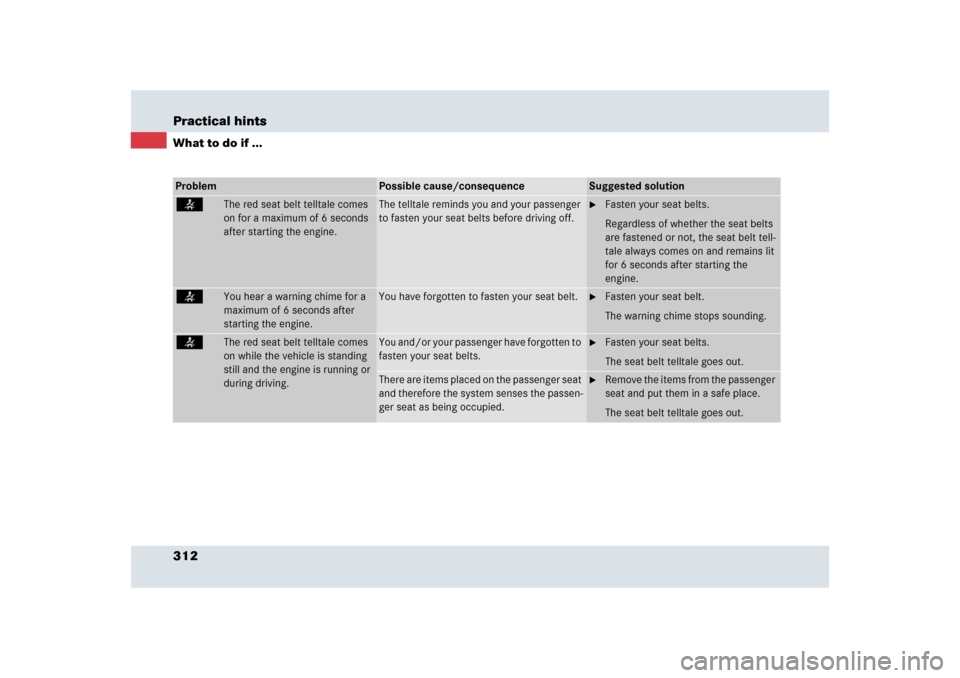
312 Practical hintsWhat to do if ...Problem
Possible cause/consequence
Suggested solution
<
The red seat belt telltale comes
on for a maximum of 6 seconds
after starting the engine.
The telltale reminds you and your passenger
to fasten your seat belts before driving off.
�
Fasten your seat belts.
Regardless of whether the seat belts
are fastened or not, the seat belt tell-
tale always comes on and remains lit
for 6 seconds after starting the
engine.
<
You hear a warning chime for a
maximum of 6 seconds after
starting the engine.
You have forgotten to fasten your seat belt.
�
Fasten your seat belt.
The warning chime stops sounding.
<
The red seat belt telltale comes
on while the vehicle is standing
still and the engine is running or
during driving.
You and/or your passenger have forgotten to
fasten your seat belts.
�
Fasten your seat belts.
The seat belt telltale goes out.
There are items placed on the passenger seat
and therefore the system senses the passen-
ger seat as being occupied.
�
Remove the items from the passenger
seat and put them in a safe place.
The seat belt telltale goes out.
Page 313 of 426
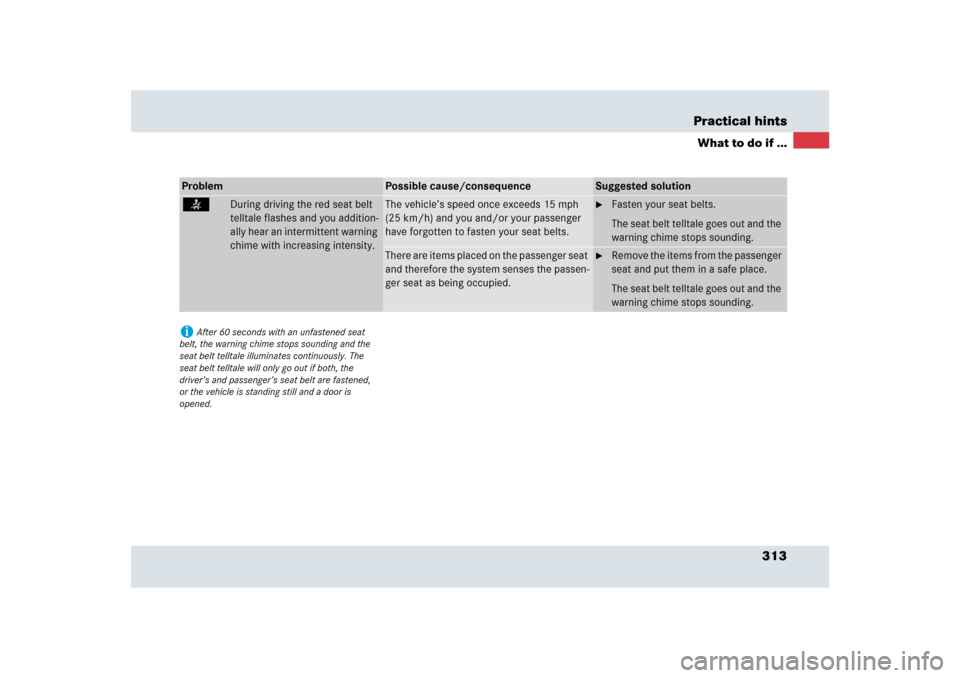
313 Practical hints
What to do if ...
Problem
Possible cause/consequence
Suggested solution
<
During driving the red seat belt
telltale flashes and you addition-
ally hear an intermittent warning
chime with increasing intensity.
The vehicle’s speed once exceeds 15 mph
(25 km/h) and you and/or your passenger
have forgotten to fasten your seat belts.
�
Fasten your seat belts.
The seat belt telltale goes out and the
warning chime stops sounding.
There are items placed on the passenger seat
and therefore the system senses the passen-
ger seat as being occupied.
�
Remove the items from the passenger
seat and put them in a safe place.
The seat belt telltale goes out and the
warning chime stops sounding.
i
After 60 seconds with an unfastened seat
belt, the warning chime stops sounding and the
seat belt telltale illuminates continuously. The
seat belt telltale will only go out if both, the
driver’s and passenger’s seat belt are fastened,
or the vehicle is standing still and a door is
opened.
Page 314 of 426
314 Practical hintsWhat to do if ...Problem
Possible cause/consequence
Suggested solution
1
The red SRS indicator lamp
comes on while the engine is
running.
There is a malfunction in the restraint sys-
tems. The air bags or Emergency Tensioning
Device (ETD) could deploy unexpectedly or
fail to activate in an accident.
�
Drive with added caution to the
nearest authorized
Mercedes-Benz Center.
Warning!
G
In the event that a malfunction of the SRS is
indicated as outlined above, the SRS may
not be operational. For your safety, we
strongly recommend that you contact an
authorized Mercedes-Benz Center immedi-
ately to have the system checked, otherwise
the SRS may not be deployed when needed
in an accident, which could result in serious
or fatal injury, or it might deploy
unexpectedly and unnecessarily which
could also result in an accident and/or
injury to you or to others.
Page 316 of 426

316 Practical hintsWhat to do if ...Warning!
G
Each tire should be checked every other
week when cold and inflated to the inflation
pressure recommended by the vehicle man-
ufacturer on the Tire and Loading Informa-
tion placard on the driver’s door B-pillar
(�page 269) or, if available, the tire infla-
tion pressure label on the inside of the fuel
filler flap. If your vehicle has tires of a differ-
ent size than the size indicated on the Tire
and Loading Information placard or, if avail-
able, the tire inflation pressure label, you
should determine the proper tire inflation
pressure for those tires.
As an added safety feature, your vehicle has
been equipped with a tire pressure monitor-
ing system (TPMS) that illuminates a low tire
pressure telltale when one or more of your
tires is significantly underinflated.
Accordingly, when the low tire pressure tell-
tale illuminates, you should stop and check
your tires as soon as possible, and inflate
them to the proper pressure. Driving on a
significantly underinflated tire causes the
tire to overheat and can lead to tire failure.
Underinflation also reduces fuel efficiency
and tire tread life, and may affect the vehi-
cle’s handling and stopping ability. Please
note that the TPMS is not a substitute for
proper tire maintenance, and it is the driv-
er’s responsibility to maintain correct tire
pressure, even if underinflation has not
reached the level to trigger illumination of
the TPMS low tire pressure telltale.
USA only:
Your vehicle has also been equipped with a
TPMS malfunction indicator to indicate
when the system is not operating properly.
The TPMS malfunction indicator is com-
bined with the low tire pressure telltale.
When the system detects a malfunction, the
telltale will flash for approximately
one minute and then remain continuously
illuminated. This sequence will continue
upon subsequent vehicle start-ups as long
as the malfunction exists. When the mal-
function indicator is illuminated, the system
may not be able to detect or signal low tire
pressure as intended.
TPMS malfunctions may occur for a variety
of reasons, including the installation of
replacement or alternate tires or wheels on
the vehicle that prevent the TPMS from
functioning properly. Always check the
TPMS malfunction telltale after replacing
one or more tires or wheels on your vehicle
to ensure that the replacement or alternate
tires and wheels allow the TPMS to continue
to function properly.
Page 317 of 426
317 Practical hints
What to do if ...
Lamp in center consoleProblem
Possible cause/consequence
Suggested solution
PASSENGER AIR BAG OFF
The passenger front air bag off
indicator lamp illuminates and
remains illuminated with the
weight of a typical adult or some-
one larger than a small individual
on the passenger seat.
The system is malfunctioning.
�
Have the system checked at an autho-
rized Mercedes-Benz Center as soon
as possible.
�
Also read and observe any messages
in the multifunction display and follow
corrective steps (
�page 324).
Warning!
G
If the PASSENGER AIR BAG OFF indicator
lamp illuminates and remains illuminated
with the weight of a typical adult or some-
one larger than a small individual on the pas-
senger seat, do not have any passenger use
the passenger seat until the system has
been repaired.
Page 318 of 426
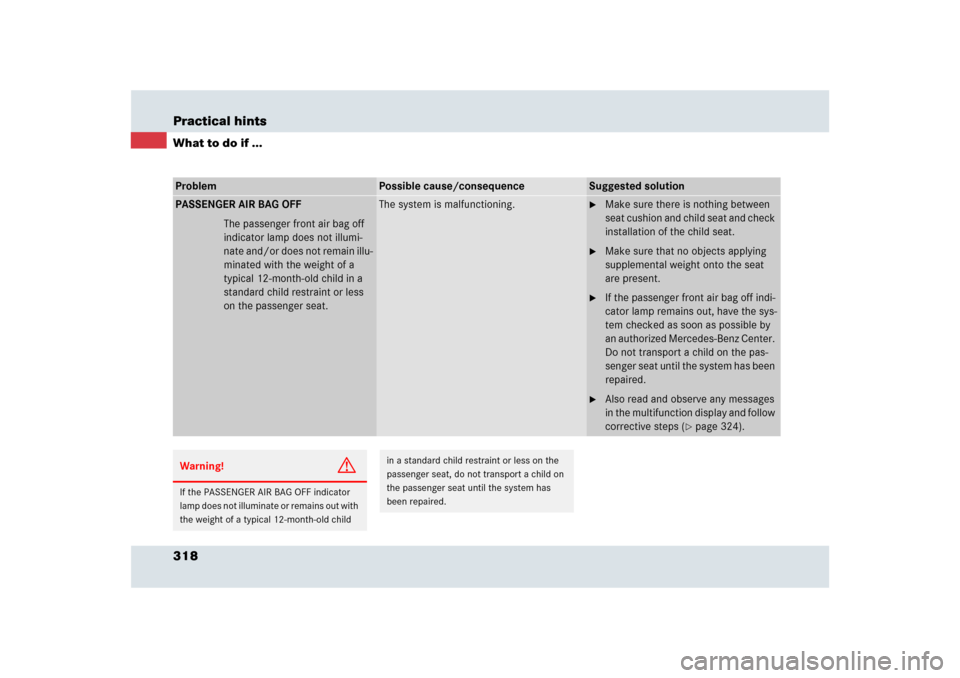
318 Practical hintsWhat to do if ...Problem
Possible cause/consequence
Suggested solution
PASSENGER AIR BAG OFF
The passenger front air bag off
indicator lamp does not illumi-
nate and/or does not remain illu-
minated with the weight of a
typical 12-month-old child in a
standard child restraint or less
on the passenger seat.
The system is malfunctioning.
�
Make sure there is nothing between
seat cushion and child seat and check
installation of the child seat.
�
Make sure that no objects applying
supplemental weight onto the seat
are present.
�
If the passenger front air bag off indi-
cator lamp remains out, have the sys-
tem checked as soon as possible by
an authorized Mercedes-Benz Center.
Do not transport a child on the pas-
senger seat until the system has been
repaired.
�
Also read and observe any messages
in the multifunction display and follow
corrective steps (
�page 324).
Warning!
G
If the PASSENGER AIR BAG OFF indicator
lamp does not illuminate or remains out with
the weight of a typical 12-month-old child
in a standard child restraint or less on the
passenger seat, do not transport a child on
the passenger seat until the system has
been repaired.